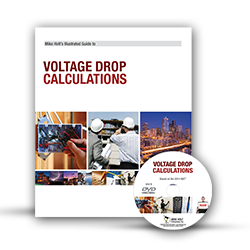Voltage Drop Calculations
Part ONE
The purpose of the National Electrical Code is the practical safeguarding of persons and property from hazards arising by the use of electricity. The NEC does not generally consider voltage drop to be a safety issue. As a result, the NEC contains six recommendations (Fine Print Notes) that circuit conductors be sized sufficiently large enough so that reasonable efficiency of equipment operation can be provided. In addition, the NEC has five rules that required conductors be sized to accommodate the voltage drop of the circuit conductors.
Fine Print Notes in the NEC are for informational purposes only and are not enforceable by the inspection authority [90-5(c)]. However, Section 110-3(b) requires equipment to be installed in accordance with the equipment instructions. Therefore, electrical equipment must be installed so that it operates within its voltage rating as specified by the manufacturer. Figure 1.
Author’s Comment: Figures are not posted on the internet.
Due to voltage drop within the circuit conductors, the operating voltage at electrical equipment will be less than the output voltage of the power supply. Inductive loads (i.e. motors, ballasts, etc.) that operate at voltage below its rating can overheat resulting in shorter equipment operating life and increased cost, as well as inconvenience for the customer. Under-voltage for sensitive electronic equipment such as computers, laser printers, copy machines, etc., can cause the equipment to lock up or suddenly power down resulting in data loss, increased cost and possible equipment failure. Resistive loads (heaters, incandescent lighting) that operate at under-voltages simply will not provide the expected rated power output, Figure 1.
Author’s Comment: Voltage drop on the conductors can cause incandescent lighting to flicker when other appliances, office equipment, or heating and cooling systems cycle on. Though this might be annoying for some, it’s not dangerous and it does not violate the NEC.
NEC RECOMMENDATIONS
The National Electrical Code contains six Fine Print Notes to alert the Code user that equipment can have improved efficiency of operation if conductor voltage drop is taken into consideration.
1. Branch Circuits – This FPN recommends that branch circuit conductors be sized to prevent a maximum voltage drop of 3%. The maximum total voltage drop for a combination of both branch circuit and feeder should not exceed 5%. [210-19(a) FPN No. 4], Figure 2.
2. Feeders – This FPN recommends that feeder conductors be sized to prevent a maximum voltage drop of 3%. The maximum total voltage drop for a combination of both branch circuit and feeder should not exceed 5%. [215-2(d) FPN No. 2], Figure 2.
Example: What is the minimum NEC recommended operating voltage for a 120 volt load that is connected to a 120/240-volt source, Figure 3 (8-11).
(a) 120 volts (b) 115 volt (c) 114 volts (d) 116 volts
Answer: (c) 114 volts The maximum conductor voltage drop recommended for both the feeder and branch circuit is 5 percent of the voltage source; 120 volts x 5% = 6 volts. The operating voltage at the load is determined by subtracting the conductor’s voltage drop from the voltage source, 120 volts – 6 volts drop = 114 volts.
3. Services – Interestingly there is no recommended voltage drop for service conductors, but this FPN reminds the Code user to consider voltage drop of the service conductors [230-31(c) FPN].
Author’s Comment: Voltage drop on long service conductors can cause incandescent lighting in the building to flicker when appliances, heating or cooling systems cycle on. For information on how to solve or reduce incandescent lighting flicker, go to: www.mikeholt.com/Newsletters.
4. Conductor Ampacity – This FPN identifies the fact that the ampacities listed in Table 310-16 do not take voltage drop into consideration [310-15 FPN No. 1].
5. Phase Converters – Phase converters have their own recommendation that the voltage drop from the power supply to the phase converter should not exceed 3% [455-6(a) FPN].
6. Recreational Vehicle Parks – Recreational Vehicles have a recommendation that the maximum voltage drop for branch circuit conductors not exceed 3% and the combination of both the branch and feeder not to exceed 5% [210-19(a) FPN No. 4 and 551-73(d) FPN].
NEC REQUIREMENTS
The National Electrical Code also contains five rules requiring circuit conductors to be increased in size to accommodate voltage drop.
Grounding Conductors – This rule states that where circuit conductors are increased in size to compensate for voltage drop, the equipment grounding conductors must also be increased in size [250-122(b)].
Author’s Comment: If, however, the circuit conductors are not increased in size to accommodate voltage drop, then the equipment grounding conductor is not required to be larger than listed in Table 250-122.
Motion Picture/Television Studios – Branch circuit conductor for 60/120 volt systems used to reduce noise in audio/video production or other similar sensitive electronics for motion and television studios must not exceed 1.5%, and the combined voltage drop of the feeder and branch circuit conductors must not exceed 2.5% [530-71(d)]. In addition, FPN No. 1 to Section 530-72(b) reminds the Code user to increase the size of the grounding conductor in accordance with Section 250-122(b).
Fire Pumps – The operating voltage at the terminals of a fire pump controller must not be less than 15% from the voltage rating of the controller while the motor is starting (lock-rotor current). In addition, the operating voltage at the terminals of the fire pump motor must not be less than 5% from the voltage rating of the motor when the motor is operating at 115 percent of it full-load current rating [695-7].
Author’s Comment: Next month in this article, I’ll give examples and graphics demonstrating the application of the NEC voltage drop rules.
DETERMINING CIRCUIT VOLTAGE DROP
When the circuit conductors have already been installed, the voltage drop of the conductors can be determined by one of two methods: Ohm’s law or the VD formula.
Ohm’s Law Method – Single-Phase Only
Voltage drop of the circuit conductors can be determined by multiplying the current of the circuit by the total resistance of the circuit conductors: VD = I x R. “I” is equal to the load in amperes and ”R” is equal to the resistance of the conductor as listed in Chapter 9, Table 8 for direct current circuit, or in Chapter 9, Table 9 for alternating current circuits. The Ohm’s law method cannot be used for three-phase circuits.
120 volt Example: What is the voltage drop of two No. 12 conductors that supply a 16 ampere, 120 volt load which is located 100 feet from the power supply (200 feet of wire), Figure 4.
(a) 3.2 volts (b) 6.4 volts (c) 9.6 volts (d) 12.8 volts
Answer: (b) 6.4 volts
Voltage Drop = I x R
“I” is equal to 16 amperes
“R” is equal to 0.4 ohms (Chapter 9, Table 9: (2 ohm/1,000 feet) x 200 feet
Voltage Drop = 16 amperes x 0.4 ohms
Voltage Drop = 6.4 volts, (6.4 volts/120 volts = 5.3% volts drop)
Operating Voltage = 120 volts – 6.4 volts
Operating Voltage = 113.6 volts
Author’s Comment: The 5.3% voltage drop for the above branch circuit exceeds the NEC’s recommendations of 3%, but it does not violate the NEC unless the 16 ampere load is rated less than 113.6 volts [110-3(b)].
240 volt Single-Phase Example: What is the operating voltage of a 44 ampere, 240 volt, single-phase load located 160 feet from the panelboard, if it is wired with No. 6 conductors, Figure 5?
(a) 233.1 volts (b) 230.8 volts (c) 228.4 volts (d) 233.4 volts
Answer: (a) 233.1 volts
Voltage Drop = I x R
“I” is equal to 44 amperes
“R” is equal to 0.157 ohms (Chapter 9, Table 9: (.49 ohm/1,000 feet) x 320 feet
Voltage Drop = 44 amperes x 0.157 ohms
Voltage Drop = 6.9 volts, (6.9 volts/240 volts = 2.9% volts drop)
Operating Voltage = 240 volts – 6.9 volts
Operating Voltage = 233.1 volts
Voltage Drop Using the Formula Method
When the circuit conductors have already been installed, the voltage drop of the conductors can be determined by using one of the following formulas:
VD = 2 x K x Q x I x D/CM - Single Phase
VD = 1.732 x K x Q x I x D/CM - Three Phase
“VD” = Volts Dropped: The voltage drop of the circuit conductors as expressed in volts.
“K” = Direct Current Constant: This is a constant that represents the direct current resistance for a one thousand circular mils conductor that is one thousand feet long, at an operating temperature of 75º C. The direct current constant value to be used for copper is 12.9 ohms and 21.2 ohms is used for aluminum conductors. The “K” constant is suitable for alternating current circuits, where the conductors do not exceed No. 1/0.
“Q” = Alternating Current Adjustment Factor: Alternating current circuits No. 2/0 and larger must be adjusted for the effects of self-induction (skin effect). The "Q" adjustment factor is determined by dividing alternating current resistance as listed in NEC Chapter 9, Table 9, by the direct current resistance as listed in Chapter 9, Table 8.
“I” = Amperes: The load in amperes at 100 percent, not 125 percent for motors or continuous loads.
“D” = Distance: The distance the load is located from the power supply, not the total length of the circuit conductors.
“CM” = Circular-Mils: The circular mils of the circuit conductor as listed in Chapter 9, Table 8.
Single-Phase Example: What is the voltage drop for a No. 6 conductor that supplies a 44 ampere, 240 volt, single-phase load located 160 feet from the panelboard, Figure 6?
(a) 4.25 volts (b) 6.9 volts (c) 3 percent (d) 5 percent
Answer: (b) 6.9 volts
VD = 2 x K x I x D/CM
K = 12.9 ohms, Copper
I = 44 amperes
D = 160 feet
CM = No. 6, 26,240 circular mils, Chapter 9, Table 8
VD = 2 wires x 12.9 ohms x 44 amperes x 160 feet/26,240 Circular Mils
VD = 6.9 volts, (6.9 volts/240 volts = 2.9% volts drop)
Operating Voltage = 240 volts – 6.9 volts
Operating Voltage = 233.1 volts
Three-Phase Example: A three-phase 208 volt, 36 kVA load is located 80 feet from the panelboard and it is wired with No. 1 aluminum conductors. What is the voltage drop of the conductors to the equipment disconnect, Figure 7?
(a) 3.5 volts (b) 7 volts (c) 3 percent (d) 5 percent
Answer: (a) 3.5 volts
VD = 1.732 x K x I x D/CM
K = 21.2 ohms, Aluminum
I = 100 amperes
D = 80 feet
CM = No. 1, 83,690 circular mils, Chapter 9, Table 8
VD = 1.732 x 21.2 ohms x 100 amperes x 80 feet/83,690 Circular Mils
VD = 3.5 volts (3.5 volts/208 volts = 1.7%)
Operating Voltage = 208 volts – 3.5 volts
Operating Voltage = 204.5 volts
I hope this short summary was helpfull. If you want to know more about this subject, please attend our seminar or order our home study video program today.
| Get Up to Speed Quickly with the Latest Information Grab one of the Home Study Courses Below |
|
| 2011 Voltage Drop Calculations DVD | 2014 Voltage Drop Calculations DVD |
 |
 |






 Products
Products Cart
Cart